Compact Dual-Band Antenna with Paired L-Shape Slots for On- and Off-Body Wireless Communication
Abstract
:1. Introduction
2. Antenna Design Analysis
2.1. Parametric Study of the Proposed Antenna
2.2. Equivalent Circuit Model
Parametric Analysis of the Circuit Model
3. Fabrication and Measurements
3.1. Antenna Testing in Free Space
3.2. Antenna Testing under Human Proximity
3.3. SAR Analysis
4. Results and Discussion
5. Conclusions
Author Contributions
Funding
Institutional Review Board Statement
Informed Consent Statement
Conflicts of Interest
References
- Shahzad, M.A.; Paracha, K.N.; Naseer, S.; Ahmad, S.; Malik, M.; Farhan, M.; Ghaffar, A.; Hussien, M.; Sharif, A.B. An Artificial Magnetic Conductor–Backed Compact Wearable Antenna for Smart Watch IoT Applications. Electronics 2021, 10, 2908. [Google Scholar]
- Zu, H.; Wu, B.; Yang, P.; Li, W.; Liu, J. Wideband and High-Gain Wearable Antenna Array with Specific Absorption Rate Suppression. Electronics 2021, 10, 2056. [Google Scholar] [CrossRef]
- Bright, Y.A.; Tchao, E.T.; Rehman, M.; Khan, M.M.; Ahmad, S. Study of a Printed Split-Ring Monopole for Dual-Spectrum Communications. Heliyon 2021, 7, 7928. [Google Scholar]
- Li, W.; Zu, H.; Liu, J.; Wu, B. A Low-Profile Ultrawideband Antenna Based on Flexible Graphite Films for On-Body Wearable Applications. Materials 2021, 14, 4526. [Google Scholar] [CrossRef]
- Zhang, J.; Meng, J.; Li, W.; Yan, S.; Vandenbosch, G.A.E. A Wearable Button Antenna Sensor for Dual-Mode Wireless Information and Power Transfer. Sensors 2021, 21, 5678. [Google Scholar] [CrossRef] [PubMed]
- Sun, H.; Hu, Y.; Ren, R.; Zhao, L.; Li, F. Design of Pattern-Reconfigurable Wearable Antennas for Body-Centric Communications. IEEE Antennas Wirel. Propag. Lett. 2020, 19, 1385–1389. [Google Scholar] [CrossRef]
- Le, T.T.; Yun, T.Y. Wearable Dual-Band High-Gain Low-SAR Antenna for Off-Body Communication. IEEE Antennas Wirel. Propag. Lett. 2021, 20, 1175–1179. [Google Scholar] [CrossRef]
- Yao, L.; Li, E.; Yan, J.; Shan, Z.; Ruan, X.; Shen, Z.; Ren, Y.; Yang, J. Miniaturization and Electromagnetic Reliability of Wearable Textile Antennas. Electronics 2021, 10, 994. [Google Scholar] [CrossRef]
- Rashid, T.; Hasan, M.N.; Mazumdar, P.S. An L-slot Compact Antenna for Medical Wearable Device and IoT Applications. In Proceedings of the 2021 International Conference on Information and Communication Technology for Sustainable Development (ICICT4SD), Mirpur, Bangladesh, 27–28 February 2021; pp. 100–104. [Google Scholar]
- Atanasova, G.; Atanasov, N. Small Antennas for Wearable Sensor Networks: Impact of the Electromagnetic Properties of the Textiles on Antenna Performance. Sensors 2020, 20, 5157. [Google Scholar] [CrossRef]
- Sambandam, P.; Kanagasabai, M.; Natarajan, R.; Alsath, M.G.N.; Palaniswamy, S. Miniaturized Button-Like WBAN Antenna for Off-Body Communication. IEEE Trans. Antennas Propag. 2020, 68, 5228–5235. [Google Scholar] [CrossRef]
- Joshi, R.; Hussin, E.F.N.M.; Soh, P.J.; Jamlos, M.F.; Lago, H.; AI-Hadi, A.A.; Podilchak, S.K. Dual-band, Dual-Sense Textile Antenna with AMC Backing for Localization Using GPS and WBAN/WLAN. IEEE Access 2020, 8, 89468–89478. [Google Scholar] [CrossRef]
- Mahmood, S.N.; Ishak, A.J.; Ismail, A.; Soh, A.C.; Zakaria, Z.; Alani, S. ON-Off-Body Ultra-Wideband (UWB) Antenna for Wireless Body Area Networks (WBAN): A Review. IEEE Access 2020, 8, 150844–150863. [Google Scholar] [CrossRef]
- Turbic, K.; Särestöniemi, M.; Hämäläinen, M.; Correia, L.N. User Influence on Polarization Characteristics in Off-Body Channels. IEEE Access 2020, 8, 167570–167584. [Google Scholar] [CrossRef]
- Araghi, A.; Khalily, M.; Ghannad, A.A.; Xiao, P.; Tafazolli, R. Compact Dual-band Antenna for Off-Body-Centric Communications. In Proceedings of the 2019 13th European Conference on Antennas and Propagation (EuCAP), Krakow, Poland, 20 June 2019; pp. 1–5. [Google Scholar]
- Dhulfiqar, A.; Elwi, T.A.; Ozbay, S. Metamaterial-based Printed Circuit Antenna for Biomedical Applications. Eur. J. Sci. Technol. 2021, 26, 12–15. [Google Scholar]
- Zhao, C.; Geyi, W. Design of a dual-band dual mode antenna for on/off-body communications. Microw. Opt. Technol. Lett. 2019, 62, 514–520. [Google Scholar] [CrossRef]
- Zhou, T.T.; Fang, S.J.; Jia, X. Dual-band and dual-polarised circular patch textile antenna for on/off-body WBAN applications. IET Microw. Antennas Propag. 2020, 14, 1751–8725. [Google Scholar] [CrossRef]
- Pei, R.; Leach, M.P.; Lim, E.G.; Wang, Z.; Song, C.Y.; Wang, J.C.; Zhang, W.Z.; Jiang, Z.Z.; Huang, Y. Wearable EBG-Backed Belt Antenna for Smart On-Body Applications. IEEE Trans. Ind. Inform. 2020, 16, 7177–7189. [Google Scholar] [CrossRef]
- Hong, Y.; Tak, J.; Choi, J. Dual-band dual-mode patch antenna for on–on–off WBAN applications. Electron. Lett. 2014, 50, 1895–1896. [Google Scholar] [CrossRef]
- Tak, J.; Woo, S.; Kwon, J.; Choi, J. Dual-band dual-mode patch antenna for on-/off-body WBAN communications. IEEE Antennas Wirel. Propag. Lett. 2016, 15, 348–351. [Google Scholar] [CrossRef]
- Khajeh-Khalili, F.; Shahriari, A.; Haghshenas, F. A simple method to simultaneously increase the gain and bandwidth of wearable antennas for application in medical/communications systems. Int. J. Microw. Wirel. Technol. 2021, 13, 374–380. [Google Scholar] [CrossRef]
- Zhou, L.T.; Fang, S.J.; Jia, X. A Compact Dual-Band and Dual-Polarized Antenna Integrated into Textile for WBAN Dual-Mode Applications. Prog. Electromagn. Res. Lett. 2020, 91, 153–161. [Google Scholar] [CrossRef]
- Mashaghba, H.A.; Rahim, H.A.; Soh, P.J.; Abdulmalek, M.; Adam, I.; Jusoh, M.; Sabapathy, T.; Yasin, M.N.; Rani, K.N.A. Bending Assessment of Dual-Band Split Ring-Shaped and Bar Slotted All-Textile Antenna for Off-Body WBAN/WLAN and 5G Applications. In Proceedings of the 2020 2nd International Conference on Broadband Communications, Wireless Sensors and Powering (BCWSP), Yogyakarta, Indonesia, 28–30 September 2020; pp. 1–5. [Google Scholar]
- Gabriel, S.; Lau, R.W.; Gabriel, C. The dielectric properties of biological tissues: II. Measurements in the frequency range 10 Hz to 20 GHz. Phys. Med. Biol. 1996, 41, 2251. [Google Scholar] [CrossRef] [PubMed] [Green Version]
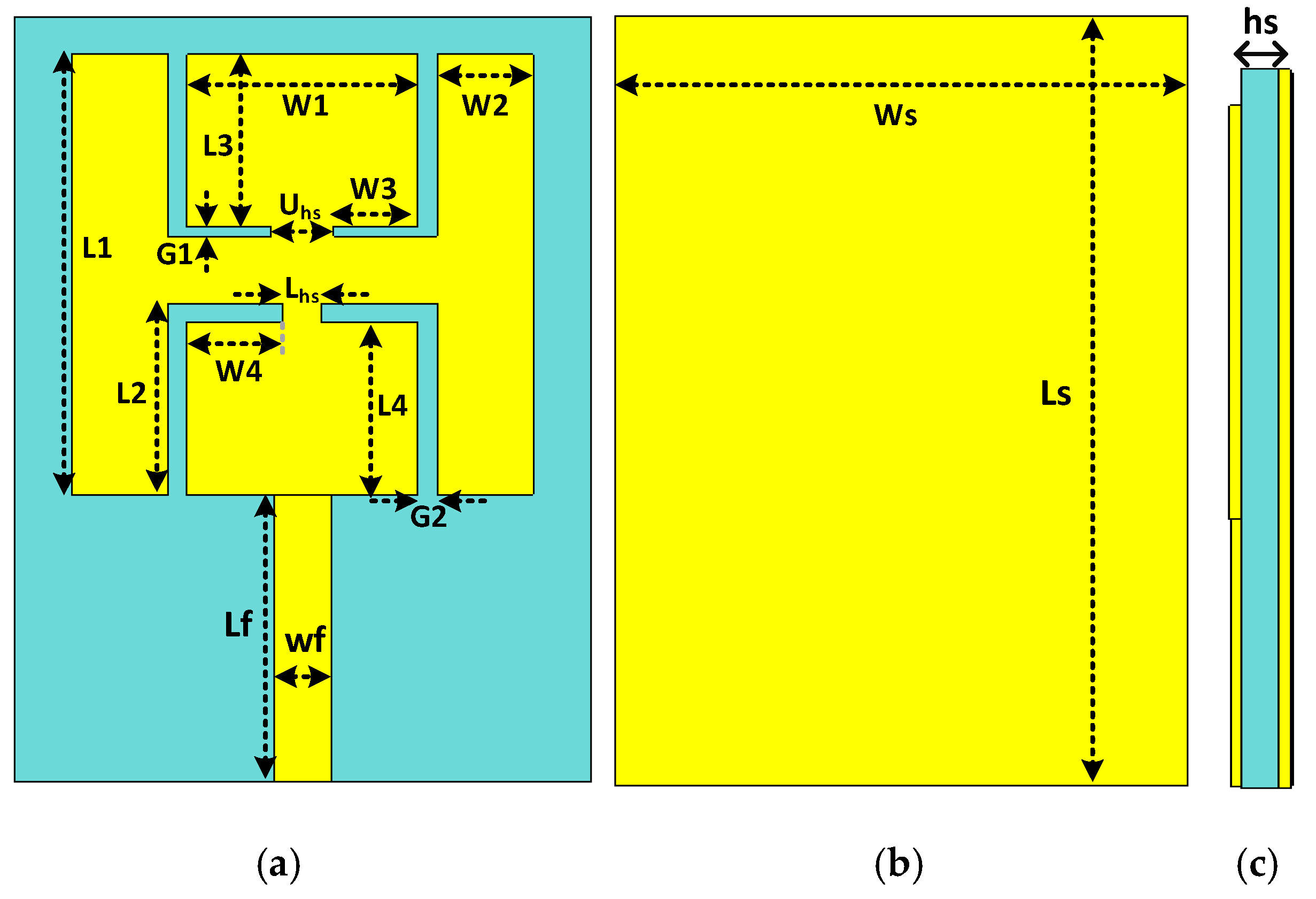

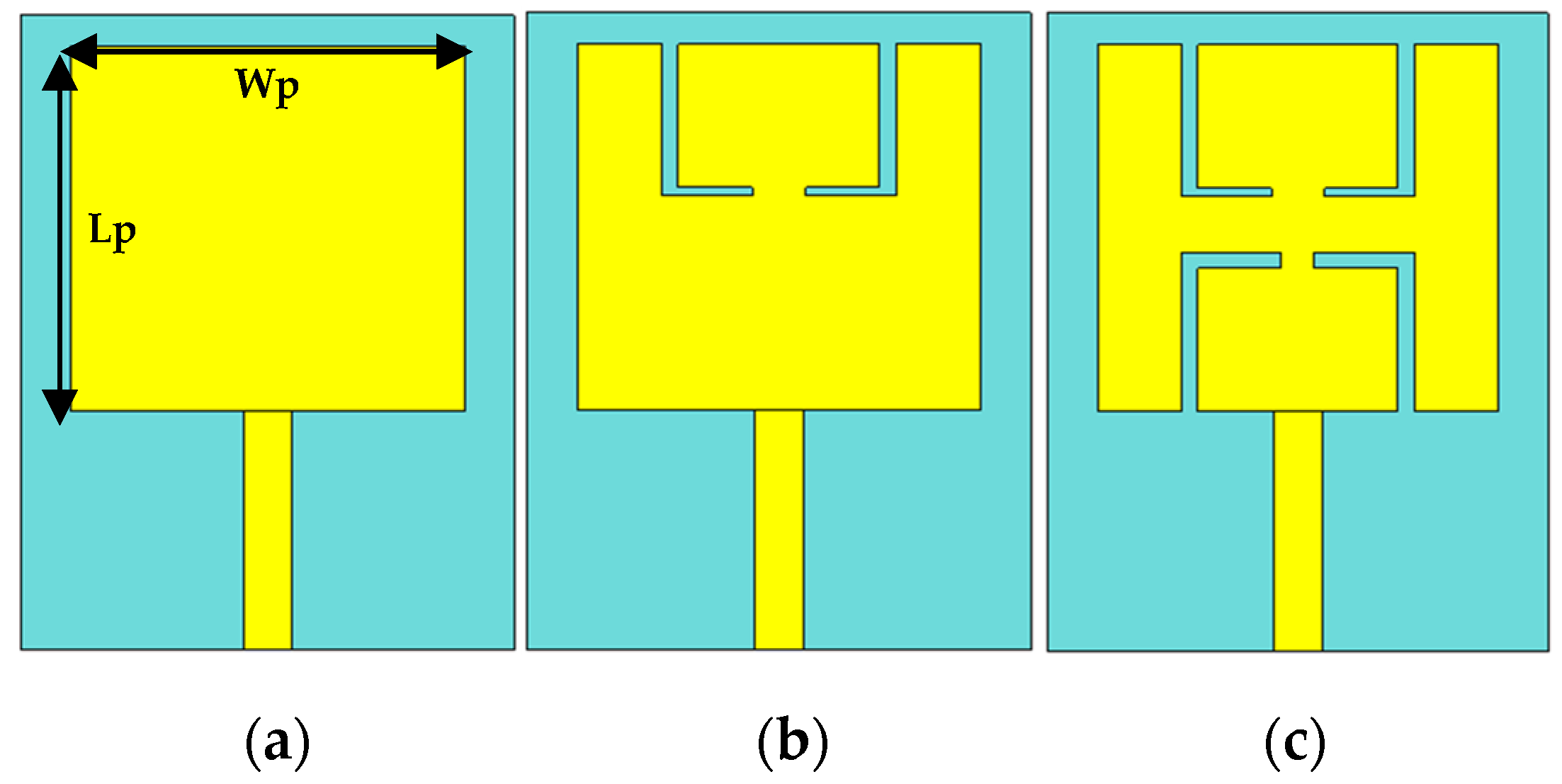
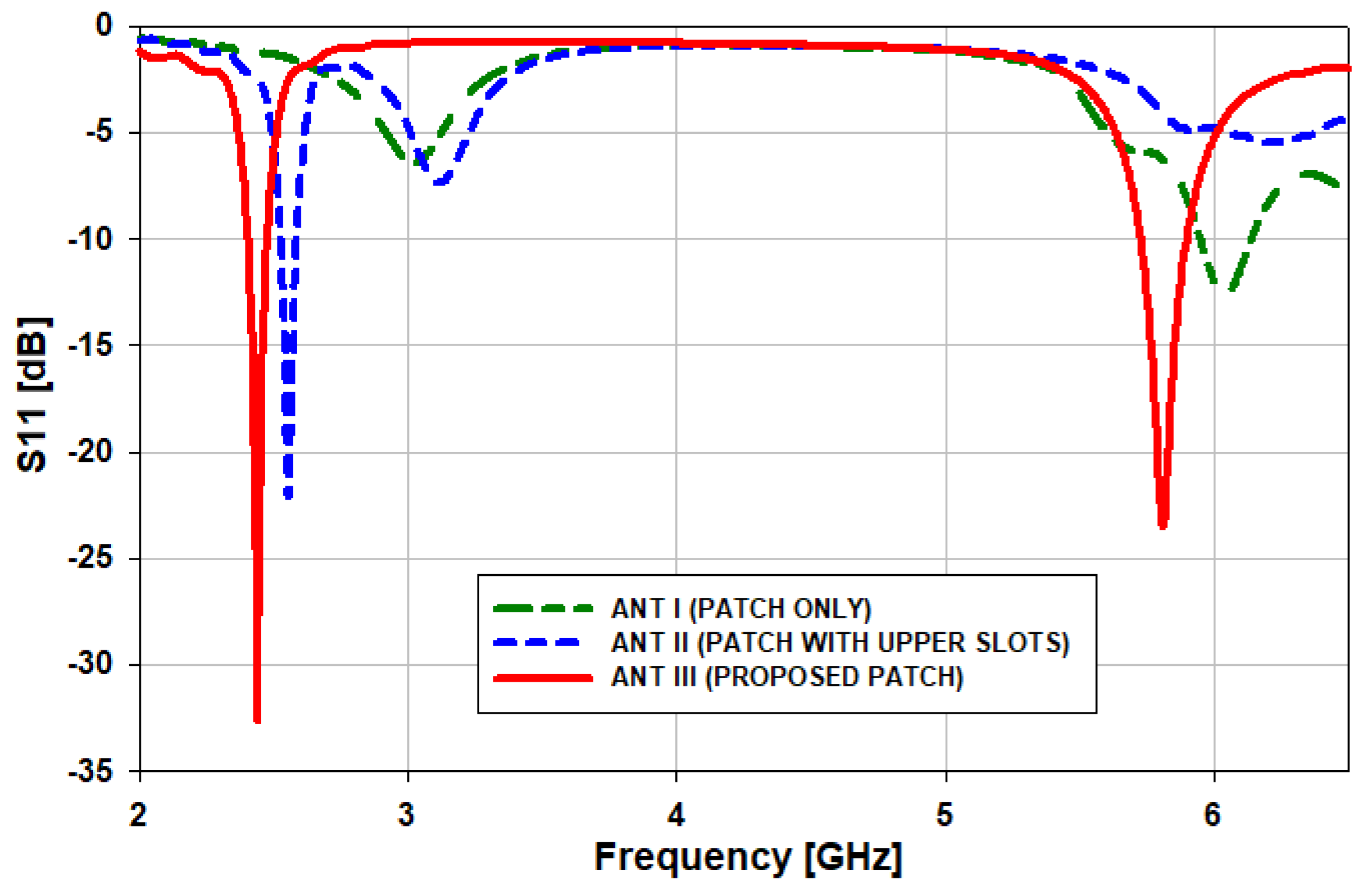
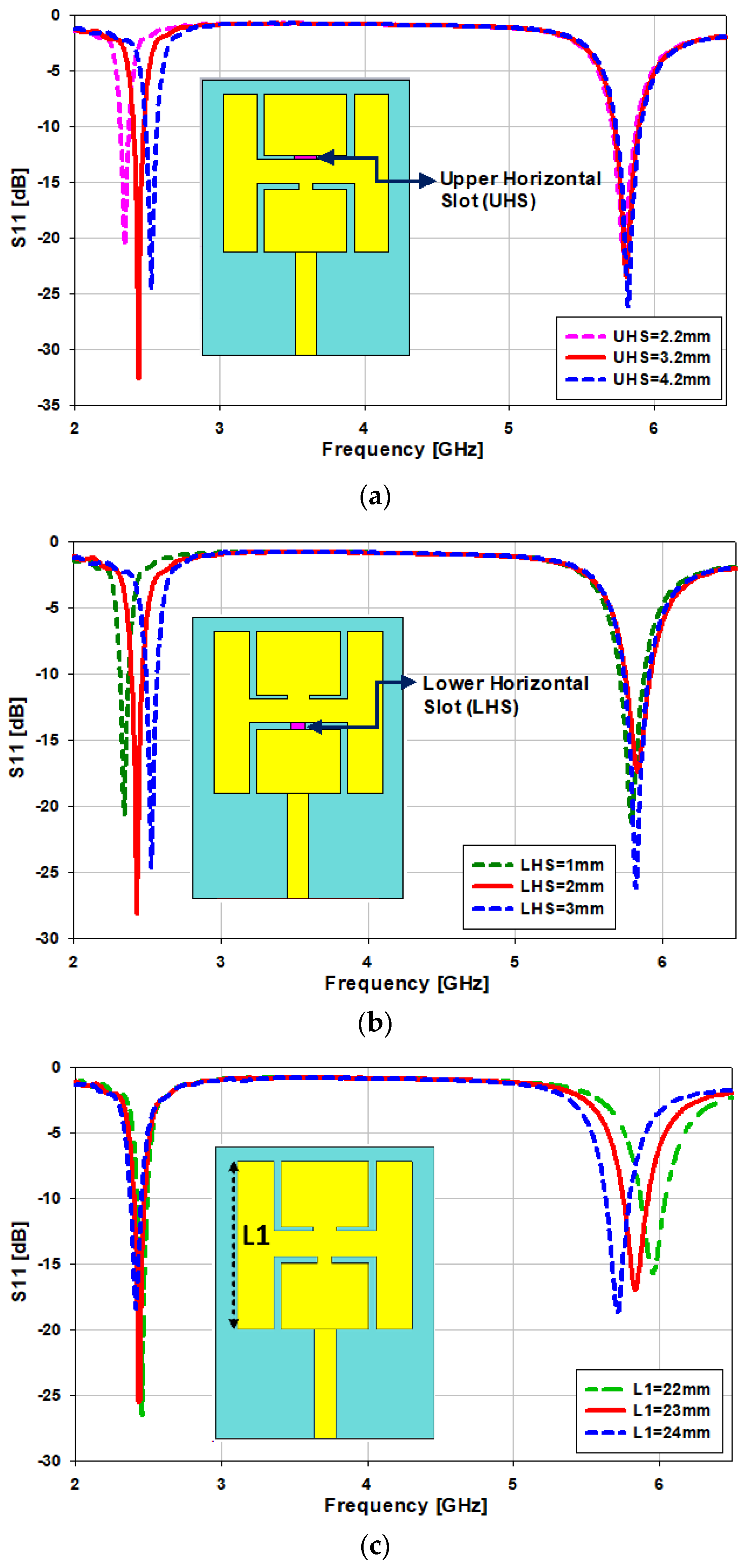
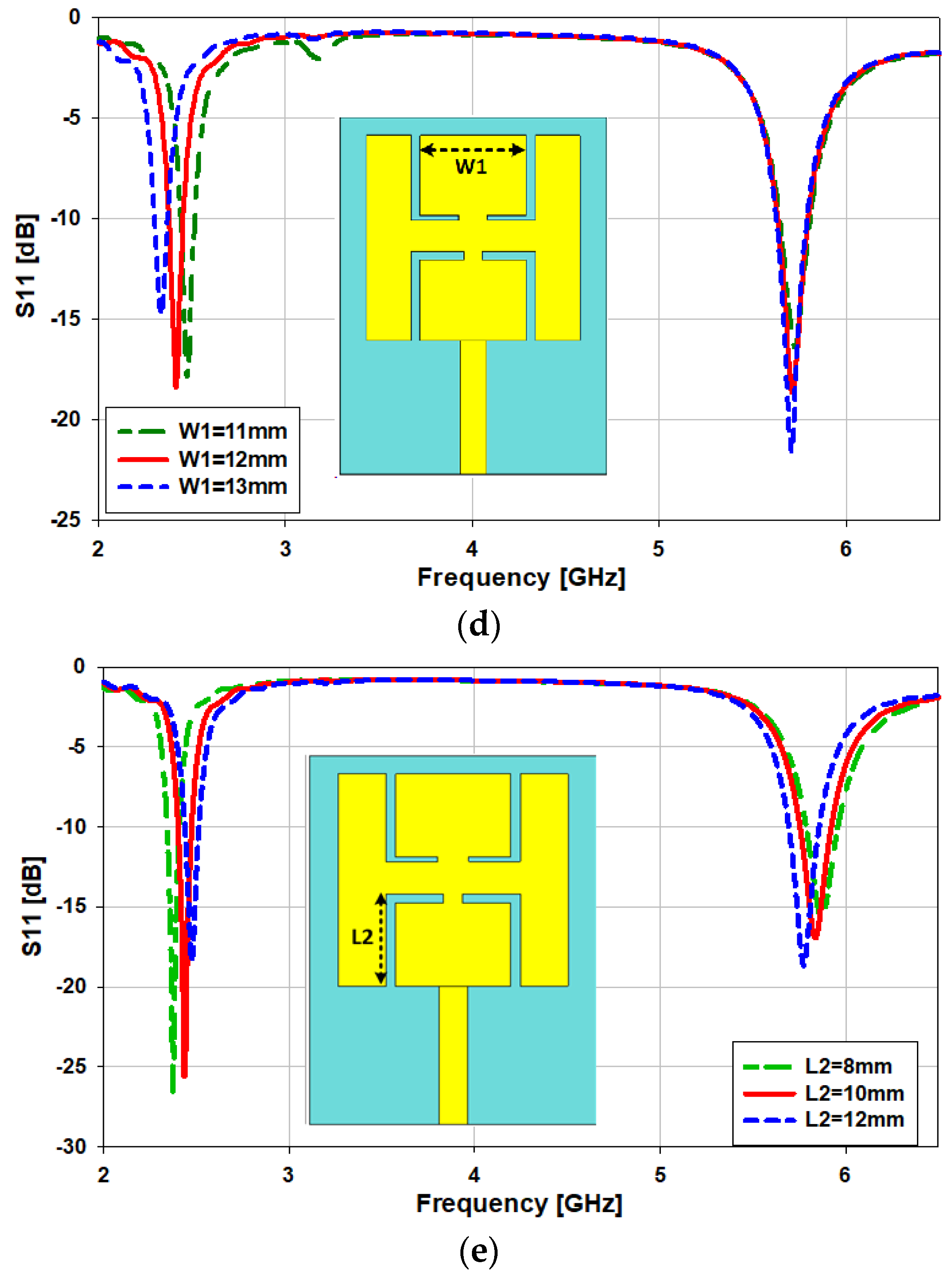

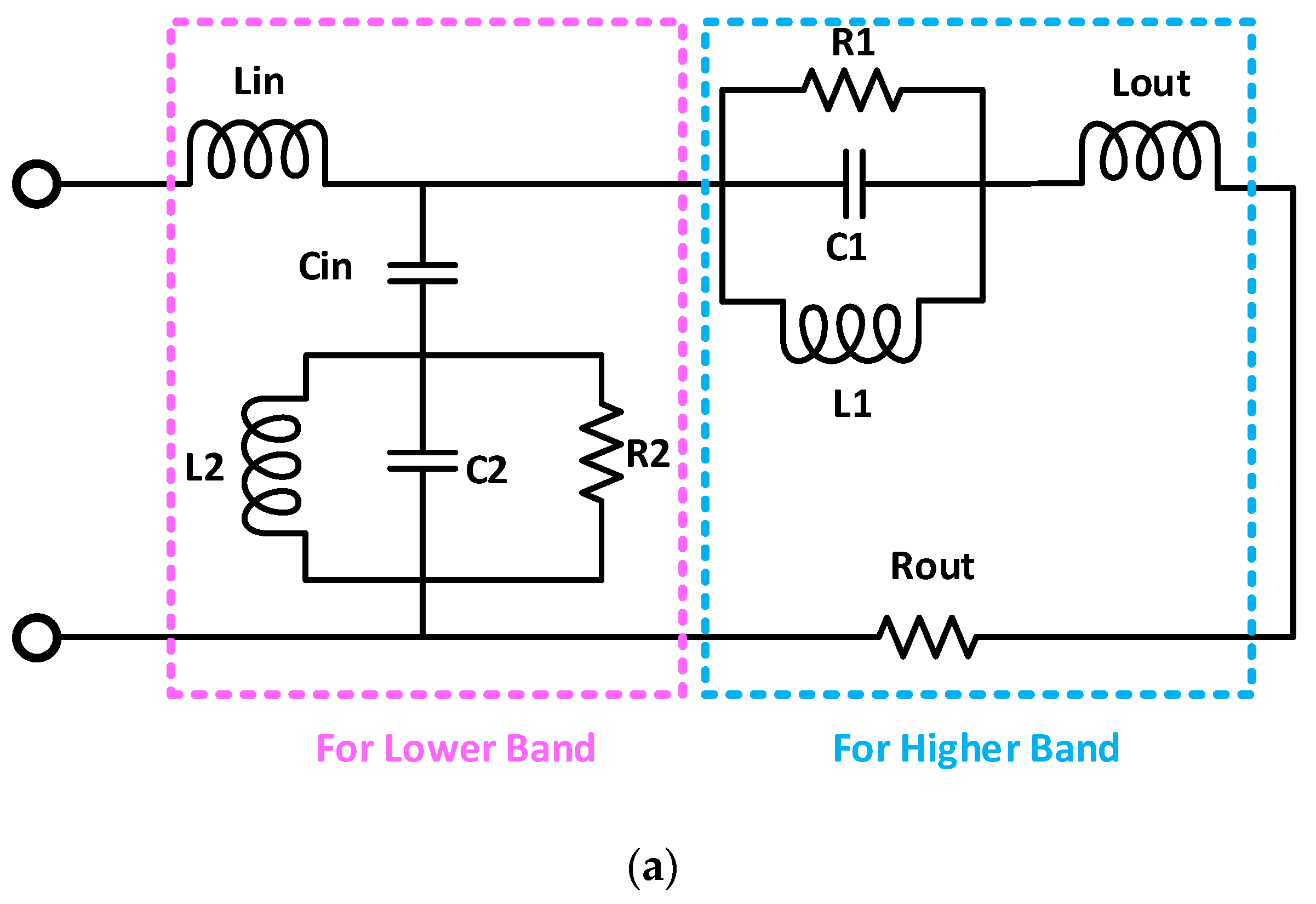



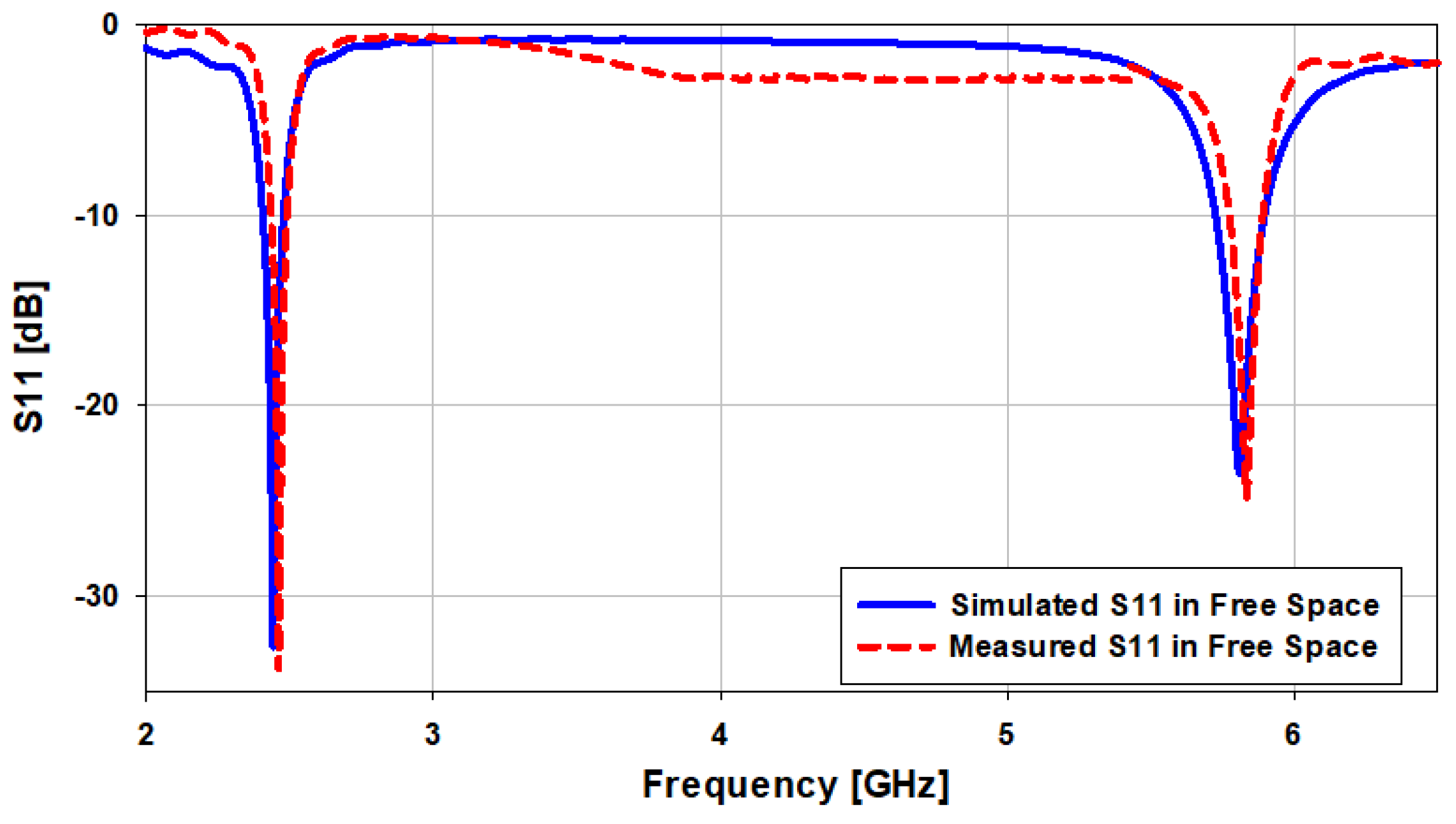



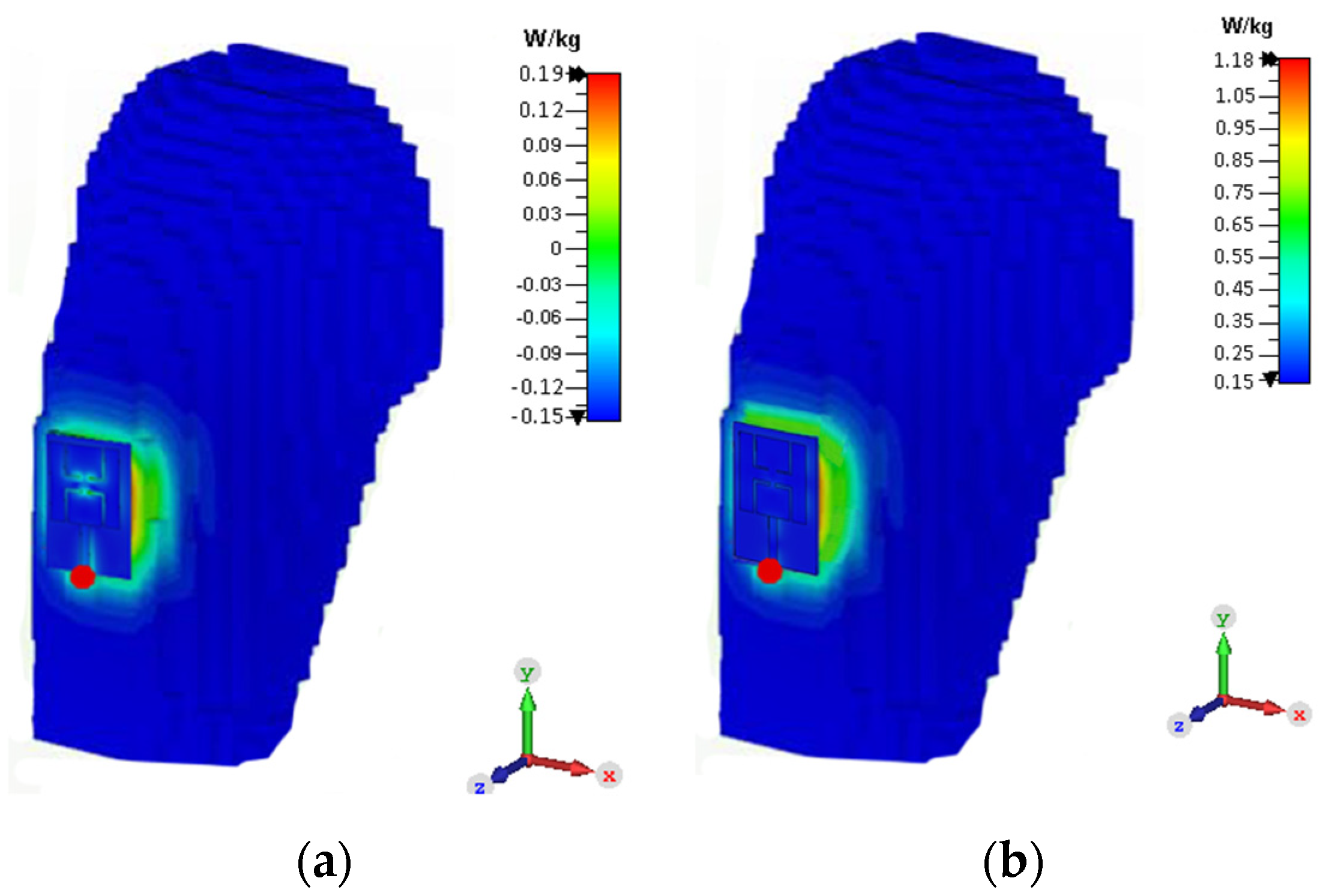
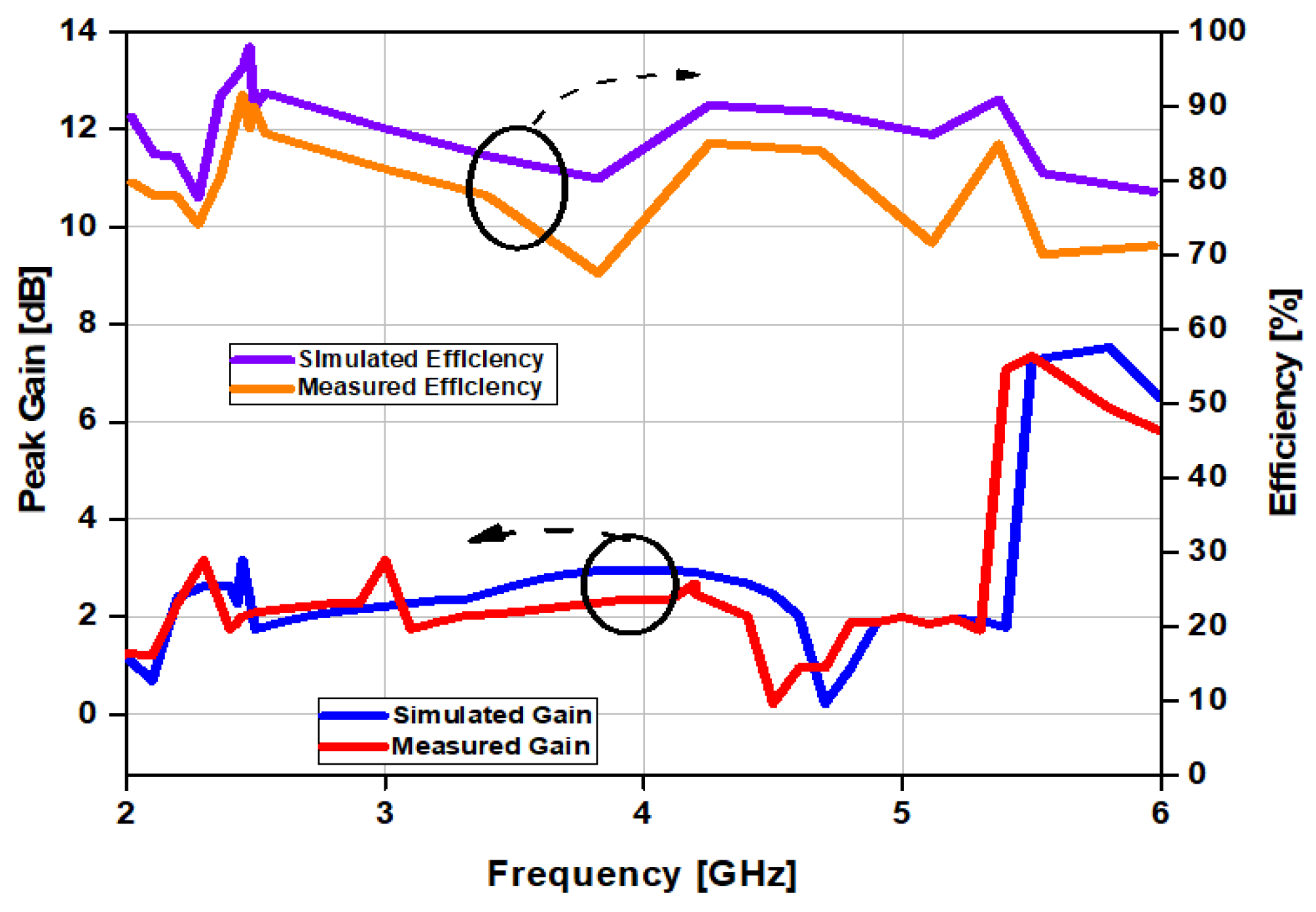
| Parameters | Values (mm) | Parameters | Values (mm) |
|---|---|---|---|
| LS | 40 | Ws | 30 |
| Lf | 15 | Wf | 3 |
| L1 | 23 | W1 | 12 |
| L2 | 10 | W2 | 5 |
| L3 | 9 | W3 | 4.4 |
| L4 | 9 | W4 | 5 |
| g1 | 0.5 | g2 | 1 |
| Lhs | 2 | Uhs | 3.2 |
| Capacitors | Values (pF) | Inductors | Values (nH) | Resistors | Values (Ω) |
| Cin | 3 | Lin | 6 | Zs | 50 |
| C1 | 2 | L1 | 4.4 | R1 | 2200 |
| C2 | 1.115 | L2 | 2 | R2 | 760 |
| Lout | 2 | Rout | 15 |
| Layers | Permittivity | Electrical Conductivity (S/m) | Density (kg/m3) | Thickness (mm) |
|---|---|---|---|---|
| Skin | 41.3 | 0.895 | 1121 | 2 |
| Fat | 5.3 | 0.049 | 780 | 3 |
| Muscle | 54.8 | 0.955 | 1121 | 8 |
| Ref. No. | Dimensions (mm3) | Frequency (GHz) | Substrate Material | Bandwidth (%) | Peaks Gain (dBi) | SAR (W/kg) | Proposed Technique |
|---|---|---|---|---|---|---|---|
| [17] | 50 × 50 × 0.6 | 2.45/5.8 | FR-4 | 4.2/ 10.5 | 1.2/7.9 | 0.81/0.24 | Patch with Two Arms |
| [18] | 100 × 100 × 2 | 2.45/5.8 | Felt | 11.9/2.18 | 6.33/6.98 | 0.042/0.09 | Circular Patch |
| [19] | 100 × 30 × 3.6 | 2.45/5.8 | Leather | 10.2/ 23.1 | 5.10/3.3 | 0.87/0.13 | Belt-Shaped |
| [20] | 30.5 × 62 × 3.15 | 2.45/5.8 | Taconic TLY | 3.47/2.58 | 1.51/6.44 | -------- | D-Shaped Patch |
| [21] | 30 × 45 × 3.2 | 2.45/5.8 | FR-4 | 4.9/2.8 | 3.09/0.64 | -------- | Parasitic Patches |
| [22] | 80 × 92 × 2 | 2/5.8 | Felt | 9.48 | 8.26/9.86 | -------- | Triple Transmission Lines |
| [23] | 100 × 100 × 3.2 | 2.45/5.8 | F4B | 2.57/5.22 | 1.9/5.9 | 0.254/0.074 | Circular Patch |
| [24] | 70 × 70 × 3 | 2.45/3.5 | Felt | 5.3/3.14 | 6 | -------- | Truncated Patch |
| [This work] | 40 × 30 × 1.6 | 2.45/5.8 | FR-4 | 2.04/3.44 | 5.08/6.33 | 0.19 /1.18 | L-Slotted Patch |
Publisher’s Note: MDPI stays neutral with regard to jurisdictional claims in published maps and institutional affiliations. |
© 2021 by the authors. Licensee MDPI, Basel, Switzerland. This article is an open access article distributed under the terms and conditions of the Creative Commons Attribution (CC BY) license (https://creativecommons.org/licenses/by/4.0/).
Share and Cite
Ahmad, S.; Ghaffar, A.; Hussain, N.; Kim, N. Compact Dual-Band Antenna with Paired L-Shape Slots for On- and Off-Body Wireless Communication. Sensors 2021, 21, 7953. https://doi.org/10.3390/s21237953
Ahmad S, Ghaffar A, Hussain N, Kim N. Compact Dual-Band Antenna with Paired L-Shape Slots for On- and Off-Body Wireless Communication. Sensors. 2021; 21(23):7953. https://doi.org/10.3390/s21237953
Chicago/Turabian StyleAhmad, Sarosh, Adnan Ghaffar, Niamat Hussain, and Nam Kim. 2021. "Compact Dual-Band Antenna with Paired L-Shape Slots for On- and Off-Body Wireless Communication" Sensors 21, no. 23: 7953. https://doi.org/10.3390/s21237953
APA StyleAhmad, S., Ghaffar, A., Hussain, N., & Kim, N. (2021). Compact Dual-Band Antenna with Paired L-Shape Slots for On- and Off-Body Wireless Communication. Sensors, 21(23), 7953. https://doi.org/10.3390/s21237953









